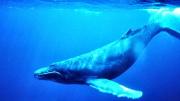Radio Program
Our regular Science and the SeaTM radio program presents marine science topics in an engaging two-minute story format. Our script writers gather ideas for the radio program from the University of Texas Marine Science Institute's researchers and from our very popular college class, Introduction to Oceanography, which we teach to hundreds of non-science majors at The University of Texas at Austin every year. Our radio programs are distributed at to commercial and public radio stations across the country.
The migration of a group of whooping cranes from their summer breeding grounds in Wisconsin to their winter hangout in Florida is unlike any other. The youngest members of the flock are led southward not by their elders, but by an ultralight aircraft. That’s because the birds have never seen the winter habitat before -- they’ve been raised in captivity and transplanted to the wild.
Some of the most popular winter residents of the Texas coast start heading north around the middle of March. But thanks to a lot of T-L-C, they’ll be back by early fall -- and in larger numbers every yearThe visitors are whooping cranes -- the tallest birds in North America. They stand up to five feet high, with wings that span more than seven feet. Their bodies are white, with black trim on their wingtips and legs, and a red patch atop their heads.
Scores of ships pass through the Strait of Gibraltar every day -- cargo ships carrying oil and citrus fruits; cruise ships carrying thousands of passengers; and military vessels that patrol Mediterranean waters.
But a much bigger exchange is taking place below them. Water is flowing in from the Atlantic Ocean at the surface, and out from the Mediterranean Sea at the bottom. But a lot more is coming in than going out.
Look though you might, you won’t see anything that looks like an eyeball on a sea urchin -- a critter that looks more like a spine-covered cactus than an animal. But it turns out that the urchin may have the equivalent of thousands of eyes -- all of them on their feet.
Researchers have known for a long time that sea urchins respond to abrupt changes in light. But they’ve been unsure about how they do it, because there are no structures that even remotely resemble eyes.
Just about everything at the top of the ocean will eventually find its way to the bottom. But just how long the trip will take varies from ocean to ocean, and even season to season.
Most of the material that falls through the oceans is small -- grains of dust that have blown off the land, dead microscopic organisms, and the waste products of small animals. Some falls as single bits, but some of it clumps together, forming small flecks known as marine snow.
It turns out that you don’t really need the Internet for a song to go viral. It happens every year with humpback whales. A new song starts off the coast of Australia and within a year it’s raced across much of the Pacific Ocean -- transmitted from whale to whale.
The massive earthquake that shook Japan in March of 2011 created a tsunami that killed thousands. The tsunami was so powerful, in fact, that its effects were felt around the globe. When it reached Antarctica, it split an ice shelf that had been stable since at least 1965, creating two icebergs as big as islands.
Every decade or two, some of the biggest coral reefs in the Pacific and Indian oceans come under attack. Like monsters from a sci-fi movie, waves of giant creatures swarm over the reefs, leaving behind dead skeletons. And so far, scientists aren’t sure just what causes these attacks.
If you’re looking for a can’t-miss fishing spot, it’s hard to beat the coastal waters of California and Peru. Thanks to a “flip” in the top layers of the Pacific Ocean, they’re some of the most productive fishing grounds in the world.
A steady breeze across a still pond or lake creates some obvious ripples, as it drags the water along with it. The effect isn’t as easy to see on the ocean, but it’s there nonetheless. In fact, the wind can move so much water that it can cause the layers of the ocean to flip over -- an effect known as upwelling.



